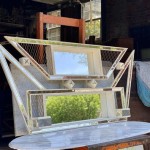Where is it Illegal to Hang Things From a Rearview Mirror?
Hanging objects from a vehicle's rearview mirror might seem like a harmless form of personal expression. From air fresheners and graduation tassels to rosaries and dream catchers, the dangling ornaments contribute to the individual aesthetic of countless car interiors. However, the practice carries significant legal implications in numerous jurisdictions. These laws exist because items obstructing a driver’s view are deemed safety hazards, potentially contributing to accidents. This article explores the various state laws regarding objects hanging from rearview mirrors, providing a comprehensive overview of where such practices are explicitly prohibited and the reasoning behind these regulations.
The legality of hanging items from a rearview mirror is not uniformly enforced across all states. Some states have explicit laws addressing the issue, while others rely on broader obstruction laws that could be interpreted to include rearview mirror decorations. The specific wording and enforcement of these laws vary widely, leading to differing interpretations and levels of scrutiny. Understanding these nuances is essential for every driver to avoid potential legal penalties and ensure road safety.
Direct Rearview Mirror Obstruction Laws
Several states have laws that directly address the issue of objects obstructing the driver’s view, specifically mentioning items hanging from the rearview mirror. These laws generally prohibit any object that significantly impedes the driver's ability to see the road, other vehicles, or pedestrians. The severity of the penalty for violating these laws varies depending on the state, ranging from minor fines to more significant penalties in cases where the obstruction contributed to an accident.
For example, California Vehicle Code Section 26708 explicitly prohibits any object or material that obstructs or reduces the driver's clear view through the windshield or side windows. Although it doesn't specifically name the rearview mirror, it’s often interpreted to include items hanging from it. Similarly, states like Pennsylvania enforce restrictions based on whether the item obstructs a clear and full view of the road through the windshield. In Illinois, motor vehicle laws prohibit obstructions to the driver's clear view through the windshield, sidelong, or rearview mirrors.
In cases where specific laws exist, law enforcement officers have clear grounds to issue citations for violations. The determination of whether an object constitutes an obstruction often rests on the officer's judgment, taking into account factors such as the size and placement of the object, as well as the driver's visibility. Court interpretations may also play a role in defining what constitutes an illegal obstruction, setting precedents that influence how these laws are enforced. It is crucial for drivers in these states to be aware of these laws and ensure that nothing hanging from their rearview mirror significantly impairs their vision.
The effectiveness of these laws hinges on consistent enforcement. In some areas, these laws may be strictly enforced, while in others, they might be overlooked unless the obstruction is particularly egregious or contributes to a traffic incident. The lack of uniform enforcement can create confusion for drivers who may be uncertain about the legality of their rearview mirror decorations. Therefore, adhering to the safest practice of minimal or no obstructions is the most prudent course of action.
General Obstruction Laws and Interpretation
Even in states without specific laws addressing rearview mirror obstructions, general obstruction laws can be used to penalize drivers with items hanging from their mirrors. These broader laws prohibit any object that obscures the driver's vision, regardless of its placement within the vehicle. The interpretation of these laws allows law enforcement to address potentially dangerous obstructions that might not be explicitly covered by more specific regulations.
For instance, many states have laws that prevent the placement of any object that "materially obstructs, obscures, or impairs the driver's clear view of the highway." This generalized language grants law enforcement discretion to determine whether an item hanging from the rearview mirror poses a sufficient risk to warrant a citation. Factors considered often include the size, shape, and position of the object, as well as the overall impact on the driver's field of vision.
The ambiguity of these general obstruction laws highlights the importance of exercising caution and common sense. Drivers should consider whether an item, even if seemingly small or innocuous, could potentially hinder their visibility, especially in challenging driving conditions such as inclement weather or heavy traffic. Proactive measures to minimize any potential obstruction contribute to safer driving habits and minimize the risk of legal repercussions.
Legal precedents set by court cases also contribute to the interpretation of general obstruction laws. Court rulings clarify the boundaries of what constitutes an illegal obstruction, providing guidance for both law enforcement and drivers. These rulings often consider expert testimony and accident reconstruction data to determine whether an obstruction was a contributing factor in a collision. By staying informed about these legal interpretations, drivers can better understand their responsibilities and avoid potential violations.
The application of general obstruction laws to rearview mirror decorations underscores the importance of understanding the legal framework in one's state. While some drivers may feel that a small air freshener or charm is harmless, law enforcement may disagree, particularly if the item is deemed to impede visibility. Prioritizing safety and ensuring an unobstructed view is the best way to avoid any potential conflicts with these laws.
Safety Implications and Contributing Factors
The primary rationale behind laws prohibiting objects hanging from rearview mirrors is the enhancement of road safety. Obstructed vision can significantly impair a driver's ability to perceive hazards, react to changing traffic conditions, and maintain control of the vehicle. These factors significantly increase the risk of accidents, especially in situations requiring quick decision-making and precise maneuvering.
Items hanging from the rearview mirror can create blind spots that obscure pedestrians, cyclists, and other vehicles. The size and placement of the obstruction directly impact the extent of the blind spot, with larger objects posing a greater risk. In complex driving environments, such as intersections or merging lanes, these blind spots can have severe consequences, leading to collisions and injuries.
Furthermore, dangling objects can be distracting to drivers. The movement of these items, especially in windy conditions, can draw the driver's attention away from the road, impairing their focus and reaction time. Even seemingly minor distractions can have detrimental effects on driving performance, increasing the likelihood of errors and accidents. Minimizing distractions is a fundamental principle of safe driving, and removing unnecessary objects from the rearview mirror is a simple yet effective way to achieve this.
The contributing factor of obstructed vision in accidents is often investigated by law enforcement and insurance companies. If an item hanging from the rearview mirror is determined to have contributed to a collision, the driver may be held liable for damages and injuries. This liability can extend beyond simple traffic fines, potentially involving civil lawsuits and increased insurance premiums. Therefore, the potential legal and financial consequences of obstructing vision underscore the importance of adhering to relevant laws and prioritizing safety.
The cumulative effect of various factors, including obstructed vision, driver distraction, and challenging driving conditions, highlights the significant safety implications of hanging objects from the rearview mirror. While individual items may seem harmless, their potential to contribute to accidents cannot be ignored. By adopting a proactive approach to road safety and minimizing potential obstructions, drivers contribute to a safer driving environment for themselves and others.
Ultimately, the legality of hanging objects from a rearview mirror is a nuanced issue with variations across different states. While some states have specific laws prohibiting the practice, others rely on broader obstruction laws that can be interpreted to include rearview mirror decorations. The enforcement of these laws also varies, depending on local priorities and the discretion of law enforcement officers. Regardless of the specific legal framework, prioritizing road safety and minimizing potential obstructions is the most prudent course of action for all drivers.

In Some States Police Can Pull You Over For Hanging An Air Freshener From Your Rearview Mirror

Can I Be Pulled Over For Something Hanging From My Rear View Mirror

Is It Illegal To Hang Items From Your Rearview Mirror In Missouri Maybe Fox 2
Is It Illegal To Hang Things From The Rearview Mirror In A Car Quora
Can You Hang Items From Your Rearview Mirror In Ks And Mo Kansas City Star

8 Classic Things To Hang From Your Rearview Mirror Glass Doctor

Are Objects Hanging From Your Rearview Mirror Illegal In Michigan

Is It Illegal To Hang Things From A Rearview Mirror House Grail

Rules Of The Road Are Items Hanging From Rearview Mirrors Illegal In
Is It Illegal To Hang Items From Rearview Mirrors In Nc Charlotte Observer








